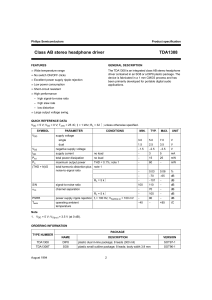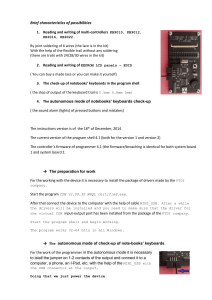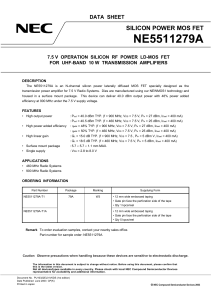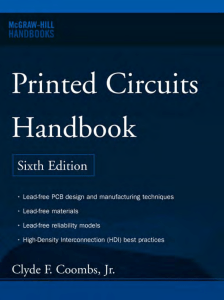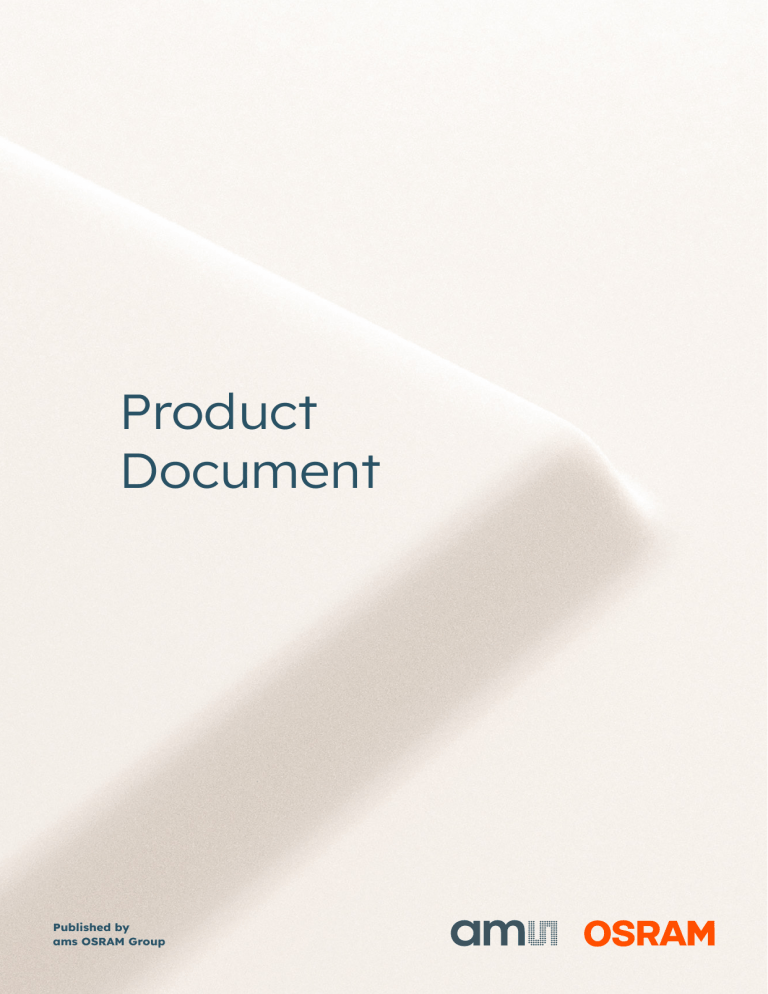
Product Document Published by ams OSRAM Group www.osram-os.com Application Note No. AN026 Manual lead-free soldering of LEDs from OSRAM Opto Semiconductors Application Note Valid for: all OSRAM Opto Semiconductors LEDs Abstract In addition to a brief fundamental consideration of the manual lead-free and lead-containing soldering process, this application note describes the essential influencing factors and their effect on the lead-free soldering process. Furthermore, the basic rules and specific guidelines associated with the manual lead-free soldering process are illustrated. Also, possible risks are discussed and the general procedure of the lead-free soldering process is described. In conclusion, an overview of the solderability of the various LED types from OSRAM Opto Semiconductors is presented, along with their ability to be reworked and repaired. Authors: Bartling Hanna / Lang Kurt-Jürgen 2018-10-12 | Document No.: AN026 1 / 16 www.osram-os.com Table of contents A. Introduction .............................................................................................................2 B. Underlying considerations ......................................................................................3 C. Important influencing factors and their implications ..............................................4 Solder ..................................................................................................................4 Flux material .......................................................................................................5 Type of soldering iron .........................................................................................6 Soldering temperature ........................................................................................6 D. Possible problem / risks .........................................................................................6 Prototyping .........................................................................................................6 Rework ................................................................................................................7 E. Basic rules for manual soldering .............................................................................7 Additional rules for lead-free soldering ...............................................................7 F. Lead-free hand soldering process ..........................................................................8 Tools and materials .............................................................................................8 General solder technique / procedure ................................................................9 Rework and repair procedure ...........................................................................10 Visual assessment of the solder joints ..............................................................11 Cleaning ............................................................................................................12 Important LED-specific points ..........................................................................12 G. Conclusion ............................................................................................................14 A. Introduction With the introduction and ratification of Directive 2002/95 (RoHS directive “on the restriction of the use of certain hazardous substances in electrical and electronic devices”) in June 2006, many production lines have switched to leadfree, RoHS-conformant technologies. In automated production sequences, the implementation of lead-free soldering processes has been carried out without huge difficulties, despite of the smaller processing window due to the higher melting temperature of the new solder. 2018-10-12 | Document No.: AN026 2 / 16 www.osram-os.com The quality, reproducibility and process stability has achieved an equally high level, although the solder heat resistance of individual SMD components such as LEDs makes it difficult to conform to the lead-free soldering process. In contrast, the introduction of a manual lead-free soldering process is still challenging, as it is more difficult to control. Today, manual soldering is almost exclusively used for the manufacture of prototypes and for repair or rework of production components, quality assurance represents the largest challenge, here. With manual lead-free soldering, the quality is essentially influenced and determined by the solder materials and equipment, the experience and ability of the operator and a continuous process control. It is therefore recommended to only carry out manual lead-free soldering with appropriate equipment and trained personnel. In addition, it should be noted than not all available LED types are suited for manual soldering or repair. B. Underlying considerations In principle, manual soldering with lead-free solder is not much more difficult than soldering with lead-containing solder. In order to achieve good results and good solder connections, the properties and differences of the two soldering processes must be thoroughly understood and considered from a technical standpoint. The essential differences between lead-free solder and tin-lead compounds is first of all, the higher melting temperature (up to 40 °C higher than tin-lead compounds, depending on the solder used), and secondly, the poorer wetting characteristic of lead-free solders. For soldering, this means that the time required for wetting the solder joints increases and the lead-free solder takes longer to spread. In addition, differences can arise in the appearance of the solder joints; lead-free connections appear to be dull and matt (without luster) in comparison to lead-containing solder connections. The quality and steadiness of soldering created manually with a soldering iron is generally influenced by several factors, including: • Composition of the solder • Activity of the flux material • Thermal characteristics of the soldering iron • Angle of soldering, dependent on the handling of the operator • Joint clearance of the two surfaces In addition to the above mentioned factors, the solder connection is ultimately dependent on the prevailing temperature and effective time. 2018-10-12 | Document No.: AN026 3 / 16 www.osram-os.com Figure 1: Different appearance of lead-containing (SnPb) and lead-free (SnAgCu) solder SnPb alloy SnAgCu alloy C. Important influencing factors and their implications Solder The type of solder used represents the most important parameter and has a decisive influence on the entire soldering process and on the subsequent connection. Through the composition of the solder and the associated properties such as solder temperature, wetting and oxidation characteristics etc, a certain process window for the soldering process is predefined. Figure 2: Side by side comparison of the process windows — lead-containing vs. leadfree Lead-containing solder Lead-free solder SnPb solder alloy 183 °C - 210 °C SnAgCu solder alloy 221 °C - 227 °C Damage level LED Damage level LED 260 °C 260 °C Process area Process area 235 °C 205 °C Low temperature 2018-10-12 | Document No.: AN026 Low temperature 4 / 16 www.osram-os.com As can be seen in Figure 2, the higher melting point of the lead-free solder leads to a reduction in the solder processing window in comparison to that of leadcontaining solder. The size of the window is determined by the melting temperature of the solder and the maximum allowable temperature, above which damage to the component occurs. In addition, the poorer wetting characteristics of lead-free solder causes a lengthening of the processing time. Compared to lead-containing solders, a factor of 2 to 3 can be assumed. Figure 3: Side by side comparison of the process window — lead containing vs. leadfree hand soldering SnPb 9 TL = 183 °C 8 8 7 7 6 6 Time [s] Time [s] 9 SnAgCu 5 4 5 4 3 3 2 2 1 1 0 0 300 325 350 Temperature [°C] 375 TL = 221 °C 300 325 350 375 Temperature [°C] Flux material The use of a flux material basically serves to activate the respective soldering surfaces of the components. It dissolves the oxidation layer of the surfaces by warming and at the same time prevents new oxidation of the solder before and during the soldering process. The flux material simultaneously reduces the surface tension of the flowing solder and in this way enhances the wetting characteristics and the flowing property. With the use of flux material, one generally has to consider whether the smoke gases which arise, depending on the type of flux material, represent a health hazard. Regardless of this, it is generally recommended to provide sufficient ventilation, or for longer periods of work, to utilize an exhaust fan. In addition, flux material also has an influence on the durability of the soldering iron tip. Since this flux material is more aggressive than tin-lead compounds, a reduction in operating life can occur. As a result, the tip must be exchanged after a shorter period of time. 2018-10-12 | Document No.: AN026 5 / 16 www.osram-os.com Type of soldering iron Many types of soldering irons are available. The main differences are the heating power and the precision of temperature regulation. With older soldering iron models, the temperature measurement and regulation usually occurs at the internal heating element. Due to the distance from the soldering tip, large deviations from the actual temperature of the soldering tip (up to 50 °C) can occur. Combined with higher melting temperatures of lead-free solder, this increases the risk of overheating or can lead to temperature losses during the manual soldering process. Better results can be achieved for lead-free solder with the help of modern soldering stations which possess regulated heat management as well as internal process monitoring. With modern soldering irons, temperature regulation occurs at the soldering tip rather than at the heating element. In addition, the soldering irons are equipped with sufficient heating power (> 80 W) and exhibit extremely fast warming characteristics. This ensures that all solder joints are created with nearly the same temperature. Soldering temperature In general, it is recommended to use the lowest temperature possible, depending on the solder used. On the one hand, this prevents damage to heatsensitive components and on the other the operating life of the soldering iron is extended. With an increase in temperature, the wetting time for lead-free solder can indeed be reduced, but this can damage certain types of components and reduce the operating life of the soldering iron. Since the melting point of lead-free solder is around 40 °C higher than the melting point of typical tin-lead compounds, the temperature of the soldering tip must be set higher as a consequence. In general, it is typical and also acceptable that the temperature of the soldering tip is set to be 50 °C higher than the melting point of the solder. However, soldering temperatures are often selected which are 100 °C higher than the melting temperature. This excess temperature is ultimately dependent on the heat capacity of the LED to be soldered, the extent of the solder joint and the size of the soldering tip. D. Possible problem / risks Prototyping With manual soldering, the most common problems are damaging the LEDs or the circuit board (base material, solder resist mask, pads etc.) and poor solder joints. Soldering of larger LEDs with a higher heat binding potential causes the greatest difficulty in most cases. An improvement can possibly be achieved with the use of an additional heat source (heating pad, IR radiator, etc.). 2018-10-12 | Document No.: AN026 6 / 16 www.osram-os.com Poor solder joints most often occur if the surfaces are not clean or are strongly oxidized. With lead-free compounds, this is seen more often. One possible remedy is the use of an aggressive flux material. However, this can lead to additional problems. Since solder wire is produced with several types of flux, some of which are more corrosive than others, an initial test should be performed with respect to its suitability. A further possibility is the use of an additional flux material for the components. Rework When reworking components already soldered with lead-free solder, it should be noted that not all alloys can be mixed together. Some combinations can lead to unreliable solder connections. Normally the same alloy as for to the former soldering is used. In case different alloys are used in parallel, it would be advantageous to mark or label the solder pads and possibly the components, in order to provide information about the solder used. Since a higher temperature is required during rework due to a change in the composition of the material, it can happen that both the components and circuit board can be damaged in the process. Careful, skilled work along with process and temperature monitoring are thus strongly recommended. Furthermore, depending on the condition and storage time of the components to be processed, a more aggressive flux material may possibly be required. E. Basic rules for manual soldering • A good heat contact between the soldering tip and the solder joint (component and PCB) must be created. This can only be achieved with flowing solder. • The flux material should perform its effect at the appropriate locations and should therefore flow freely to the locations to be soldered. This also enhances the heat transfer. • The contact between the soldering iron and the location to be soldered should only be maintained until the solder has freely flowed. • Only as much solder as needed should be used. For stranded-wire connections, the contour of the wires should remain visible. • The LEDs must not be permitted to move during the solidification process. Additional rules for lead-free soldering • The temperature of the soldering tip must be raised in comparison to that required for lead-containing solder (+ 25 °C to + 40 °C) • The upper limit must not be increased, as this would result in delamination of the circuit board or thermal damage to the components. For the soldering procedure, this means that the processing window becomes 2018-10-12 | Document No.: AN026 7 / 16 www.osram-os.com narrower. • With lead-free solder, the flow behavior is poorer; the solder time increases by 50 – 100 % in comparison to lead-containing solder. • Exertion of pressure during soldering should be avoided so that the soldering tip does become deformed or the components will damaged. • Since lead-free solder is more aggressive, there is more wear and tear on the soldering tip. The soldering stations should be switched off when not in use or when no standby function is available. • The use of fast heating soldering tips is preferable, since these are more quickly placed into operation. • After the soldering, the tip should be cleaned and tin-plated. F. Lead-free hand soldering process In general, it is recommended to prepare and provide all necessary tools, materials and additional auxiliary tools before the soldering process. This also means that the circuit board should be cleaned if necessary, in order to remove oxidation or other impurities. Care should be taken that cleansing itself does not cause damage to the circuit board or circuit traces which could interfere or inhibit the wetting of the solder. In order to minimize or prevent additional effort, it is advantageous to populate new circuit boards directly after manufacture, or package them in a vacuum or inert gas for later processing. Contamination or progressive oxidation is thereby prevented. In case of rework of already populated boards, this means that if necessary, the boards should be preheated in an appropriate oven, depending on storage conditions and time. Preheating serves to remove absorbed moisture and prevent the so-called “popcorn” effect with components. The duration and temperature of the preheating procedure is individually determined, dependent on the components on the circuit board and the storage and environmental conditions. Tools and materials As mentioned previously, lead-free solder places special demands and requirements on the soldering equipment. Representative of equipment available on the market, three appropriate and proven soldering stations are listed here. ERSA: i-CON Soldering Station & i-Tool Soldering Iron, 150 W WELLER: WD2M Soldering Station, 160 W METCAL: Soldering Station PS 800 All three systems were specially developed and optimized for lead-free soldering. In comparison to older soldering stations for example, the soldering system from ERSA possesses precise temperature regulation at the soldering tip 2018-10-12 | Document No.: AN026 8 / 16 www.osram-os.com and extremely fast warm-up characteristics. In addition, it is equipped with a process window alarm and an automatic standby sensor as well as other userfriendly functions. Other systems are similarly equipped. For the soldering irons mentioned above, several different soldering tips are available which can be specifically adapted and optimized for the component. Figure 4: Tip selection — correct geometry for each application Too small Too large Perfect geometry Correct As auxiliary tools, various sizes of tweezers are recommended for better handling of LEDs along with a desoldering braid or pump for removal of solder paste during repair work. In addition, the use of a so-called “third hand”, an adjustable fixture for holding the circuit board, and a magnifying glass can also be helpful. In general, ESD protection should additionally be provided for the components and/or the populated circuit board. This can be achieved with a grounding armband, grounded table or support, etc. When soldering, the use of solder wire with flux core is preferable. This is available in several diameters and provides a sufficient amount of flux in most cases. As an example, solder wire from EDSYN consisting of SnAgCu with NO-CLEAN flux as per F SW34 can be used. For soldering of LEDs, particularly for miniature components, a diameter of 0.35 mm is sufficient. Depending on the size of the LED or component to be soldered, heavier solder wire can be used. With the use of solder wire with a flux core, the solder and flux can spray out due to the very quick warming of the solder.The flux tends to carbonize in the process and the desired effectiveness is reduced. An improvement can be achieved with a V-formed notch in the solder wire, permitting more effective use of the flux material. General solder technique / procedure The soldering technique and correct procedure is basically not different from the old technique for lead-containing solder. After setting the required working temperature (soldering tip ≤ 350 °C for LEDs) the tip should be cleaned before each use with a moist sponge or by means of a dry pad made of steel wool. 2018-10-12 | Document No.: AN026 9 / 16 www.osram-os.com Figure 5: Example of moist sponge for cleaning soldering tips Dry cleaning has the advantage that the soldering tip is not abruptly cooled, and that no contamination arises from dirty sponges. In addition, the light scouring effect of steel wool can also easily remove heavy contamination and accumulated passive layers. Figure 6: Example of dry cleaners After cleaning, the tip must be wetted again with a sufficient amount of solder. In the next step, the solder joint is heated. Here, the solder pad and LED connection contact are heated together by simultaneous contact with the soldering tip. The LED is then attached with the addition of a small amount of solder in the corner between the soldering tip and the LED pin. Afterwards, the solder wire should be pulled away and one should wait for a short moment. Then, the solder is again applied to the lead or solder joint until the location has been sufficiently filled with solder. The solder wire is then pulled away and finally, the soldering tip is removed from the solder joint. The other contact connections are soldered in a similar manner. Before replacing the soldering iron in the holder, the tip should be checked once again and re-tinned if necessary (procedure according to the IPC recommendation). Rework and repair procedure The procedure for repair or rework of solder connections differs somewhat from the prementioned soldering technique, since the solder connection is already present. With repair, a defective component is normally replaced with a 2018-10-12 | Document No.: AN026 10 / 16 www.osram-os.com functioning part. The existing solder connection must be melted and the solder removed by means of a desoldering braid or a pump. With rework, however, individual solder joints are reworked because they are possibly damaged or not sufficiently formed. Here, it is also generally true that the soldering iron tip should be cleaned and wetted with solder before use. 1. Heat the solder connections until the solder completely melts In general, the soldering iron should be held at the connection location with the largest amount of solder. In order to achieve a good heat transfer, the tip should be simultaneously held against the solder pad and the connection contact of the component. 2. Remove the liquid solder by means of a desoldering braid or a pump (repair) 3. Apply appropriate solder if necessary (rework) The solder wire is applied to the surface of the melted solder so that the solder is melted there instead of at the soldering tip. In order to prevent damage to the component of the circuit board material, a maximum contact time of 3 seconds should not be exceeded. 4. Solidification of the solder connection After the soldering tip is removed, the connection solidifies again after a few seconds and other leads of the component can be soldered. 5. Cleaning the solder joints In case cleaning is required, it is recommended to eliminate the flux residue as soon as possible. As a rule, dried residue adheres more tenaciously and can only be removed with greater difficulty and by more aggressive means. Visual assessment of the solder joints After soldering, a visual assessment should be performed in any case, with respect to the appearance and quality of the connection. The person carrying out this assessment should be trained in this regard and have sufficient experience. For a confident and reliable assessment, criteria according to IPC-Standard (IPC-A-610) are drawn upon worldwide. A few excerpts include: • The solder joint should be uniform and smooth in appearance (shiny is not required). • The solder should taper off from the inserted parts (small contact angle). • The surface of the solder joint should be unbroken. • The contours of the soldered parts should be recognizable in the solder joint. • The solder joint must contain sufficient solder. Additional information and exact details can be obtained from the IPC Standard. 2018-10-12 | Document No.: AN026 11 / 16 www.osram-os.com Cleaning In most cases, final cleaning is only necessary to remove any flux residue which may be present. Essentially, other residues or contamination should not be present. Often, various cleansing solutions or cleaning by means of an ultrasonic bath is recommended by solder manufacturers. With the presence of LEDs, however, this is only conditionally or not at all possible. In principle, isopropyl alcohol (IPA) can be used, since this is also suitable and approved for cleaning LEDs from OSRAM Opto Semiconductors. If other cleansing solutions are applied, their suitability should be tested beforehand, particularly if there is associated damage to the LED. Because of worldwide regulations, cleansers such as FREON or other compounds containing chloroflurocarbons (CFCs) should not be used. Cleaning by means of an ultrasonic bath is not recommended for LEDs. The reason for this is that the influence on the LEDs is dependent on the ultrasonic power, the duration of treatment and the cleansing solution used. If ultrasonic cleaning cannot be avoided, it must first be determined whether the LEDs will be damaged in the process. In the best and ideal case, cleaning is not required if solder with so-called NOCLEAN flux is used. With this type of flux material, it is not necessary to remove the remaining residue from the connections or circuit board in order to guarantee reliability. It is simpler as well to resort to water-soluble flux material. Meanwhile, there are systems which also permit better wetting of lead-free materials without nitrogen. Important LED-specific points Since LED packages predominantly consist of plastic and ceramic, the direct contact with a hot soldering tip can often lead to damage of the device. This applies exceptionally to the plastic optics of the LEDs. In addition, it should be noted that with higher soldering tip temperatures, heat is transferred faster to the package via the connection contacts.The prescribed solder times should not be exceeded, since this can otherwise damage the component. It should also be noted that with the various packaging types, the size and form of the connection contacts vary as well. For optimal soldering results, it is recommended to use individually adapted soldering tips. If a soldering tip is too large or wide for miniature components, for example, this can lead to overheating and thus damages to the component package. If a small, narrow tip is used for larger contacts, however, insufficient heat is available for a good solder connection. Particular experience combined with special care and higher demands are required for the processing of LED with high power housings. The reason for this is the heat slug integrated in the package base. For optimal heat transfer, this must be affixed or soldered to the circuit board. Soldering of the heat slug itself can only occur with the help of solder paste and an additional heating plate. 2018-10-12 | Document No.: AN026 12 / 16 www.osram-os.com Since the heat slug is embedded in the package base, direct contact with the soldering iron is not possible; for this reason, rework at the heat slug cannot be carried out. Generally it is advisable to use an additional heating plate for lead-free soldering of LEDs, especially if an insulated metal substrate is utilized. In the following, Table 1 provides an overview of the manual solderability of various LED types from OSRAM Opto Semiconductors as well as their repair and rework capability. Table 1: Overview of manual solderability and rework / repair capability LED Type Exemplar Radial or Throughhole LED T1 T1 3/4 Sidelooker Miniature Components Smart LED CHPILED FIREFLY 0402 Mini Top Locker Mini TOPLED TOPLED E1608 FIREFLY E1608 Point LED Side Looker FIREFLY 0402 Micro SIDELED SIDELED Top Looker TOPLED TOPLED with lens TOPLED Black TOPLED Black Surface TOPLED E3014 Multi TOPLED MULTILED CHIPLED Multi CHIPLED DISPLIX DURIS E DURIS P DURIS S Mid power LED Adv. Power TOPLED 2018-10-12 | Document No.: AN026 Manually solderable Rework possible Capable of repair 13 / 16 www.osram-os.com Table 1: Overview of manual solderability and rework / repair capability Manually solderable Rework possible Capable of repair LED Type Exemplar Ceramic LED OSRAM OSTAR Projection Compact OSRAM OSTAR Stage OSLON Compact OSLON Signal OSLON SSL OSLON Square OSLON SX OSLON Boost conditionally possible (only with special equipment and solder paste) conditionally possible (only with special equipment and solder paste) Epoxy SMD (Bottom only terminated)n/ QFN style OSLON Black Series OSLON Black Flat TOPLED Compact 4014 DURIS P5 DURIS E5 DURIS S2 DURIS S5 DURIS S8 OSRAM OSTAR Projection Cube SYNIOS P2720 SYNIOS E4014 conditionally possible (only with special equipment and solder paste) conditionally possible (only with special equipment and solder paste) Flash LED OSLUX Platform High Power LED OSCONIQ P DURIS OSRAM OSTAR Projection Compact OSLON SYNIOS conditionally possible (Heat slug only with solder paste) conditionally possible (Heat slug not possible) conditionally possible (only with additional heating plate) Ultra high power OSRAM OSTAR Projection Power SOLERIQ S OSLON Black Flat DURIS S10 OSLON Compact PL conditionally possible (Heat slug only with solder paste) conditionally possible (Heat slug not possible) conditionally possible (only with additional heating plate) G. Conclusion Equally good results and reliable solder connections can also be achieved and created with lead-free solder. 2018-10-12 | Document No.: AN026 14 / 16 www.osram-os.com The prerequisite for this, however, is that one thoroughly understands the properties and differences of the new solder and also considers the corresponding process from a technical standpoint. In addition, with manual soldering, it is generally recommended to take into account the specific features of the component or LED such as the package form, lead size, etc. when defining the process window. Basically, manual soldering with lead-free solder is not much more difficult than soldering with lead-containing solder, so long as work is performed with appropriate equipment, qualified employees and the fundamental ground rules are strictly maintained. 2018-10-12 | Document No.: AN026 15 / 16 www.osram-os.com Don't forget: LED Light for you is your place to be whenever you are looking for information or worldwide partners for your LED Lighting project. www.ledlightforyou.com ABOUT OSRAM OPTO SEMICONDUCTORS OSRAM, Munich, Germany is one of the two leading light manufacturers in the world. Its subsidiary, OSRAM Opto Semiconductors GmbH in Regensburg (Germany), offers its customers solutions based on semiconductor technology for lighting, sensor and visualization applications. OSRAM Opto Semiconductors has production sites in Regensburg (Germany), Penang (Malaysia) and Wuxi (China). Its headquarters for North America is in Sunnyvale (USA), and for Asia in Hong Kong. OSRAM Opto Semiconductors also has sales offices throughout the world. For more information go to www.osram-os.com. DISCLAIMER PLEASE CAREFULLY READ THE BELOW TERMS AND CONDITIONS BEFORE USING THE INFORMATION SHOWN HEREIN. IF YOU DO NOT AGREE WITH ANY OF THESE TERMS AND CONDITIONS, DO NOT USE THE INFORMATION. The information provided in this general information document was formulated using the utmost care; however, it is provided by OSRAM Opto Semiconductors GmbH on an “as is” basis. Thus, OSRAM Opto Semiconductors GmbH does not expressly or implicitly assume any warranty or liability whatsoever in relation to this information, including – but not limited to – warranties for correctness, completeness, marketability, fitness for any specific purpose, title, or non-infringement of rights. In no event shall OSRAM Opto Semiconductors GmbH be liable – regardless of the legal theory – for any direct, indirect, special, incidental, exemplary, consequential, or punitive damages arising from the use of this information. This limitation shall apply even if OSRAM Opto Semiconductors GmbH has been advised of possible damages. As some jurisdictions do not allow the exclusion of certain warranties or limitations of liabilities, the above limitations and exclusions might not apply. In such cases, the liability of OSRAM Opto Semiconductors GmbH is limited to the greatest extent permitted in law. OSRAM Opto Semiconductors GmbH may change the provided information at any time without giving notice to users and is not obliged to provide any maintenance or support related to the provided information. The provided information is based on special conditions, which means that the possibility of changes cannot be precluded. Any rights not expressly granted herein are reserved. Other than the right to use the information provided in this document, no other rights are granted nor shall any obligations requiring the granting of further rights be inferred. Any and all rights and licenses regarding patents and patent applications are expressly excluded. It is prohibited to reproduce, transfer, distribute, or store all or part of the content of this document in any form without the prior written permission of OSRAM Opto Semiconductors GmbH unless required to do so in accordance with applicable law. OSRAM Opto Semiconductors GmbH Head office: Leibnizstr. 4 93055 Regensburg Germany www.osram-os.com 2018-10-12 | Document No.: AN026 16 / 16
